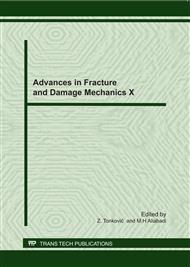p.460
p.464
p.468
p.472
p.476
p.480
p.484
p.490
p.494
Fatigue Crack Propagation in New Generation Aluminium Alloys
Abstract:
The fatigue crack propagation behaviour of a new third generation Al-Cu-Li alloy type 2050-T84 developed for aeronautical applications is studied in comparison to a new generation Al-Cu-Mg alloy type 2022-T851. The alloy resistance against crack growth is shown to depend on alloy composition, aging condition and atmosphere environment. The crack path and the growth rate at moderate DK and in the near-threshold domain are discussed in terms of the slip morphology with respect to the microstructure. The different crack propagation regimes, as identified by mean of micro-fractographic observations and EBSD analysis are discussed on the basis of a modelling framework elaborated for conventional metallic alloys.
Info:
Periodical:
Pages:
476-479
Citation:
Online since:
September 2011
Price:
Сopyright:
© 2012 Trans Tech Publications Ltd. All Rights Reserved
Share:
Citation:


